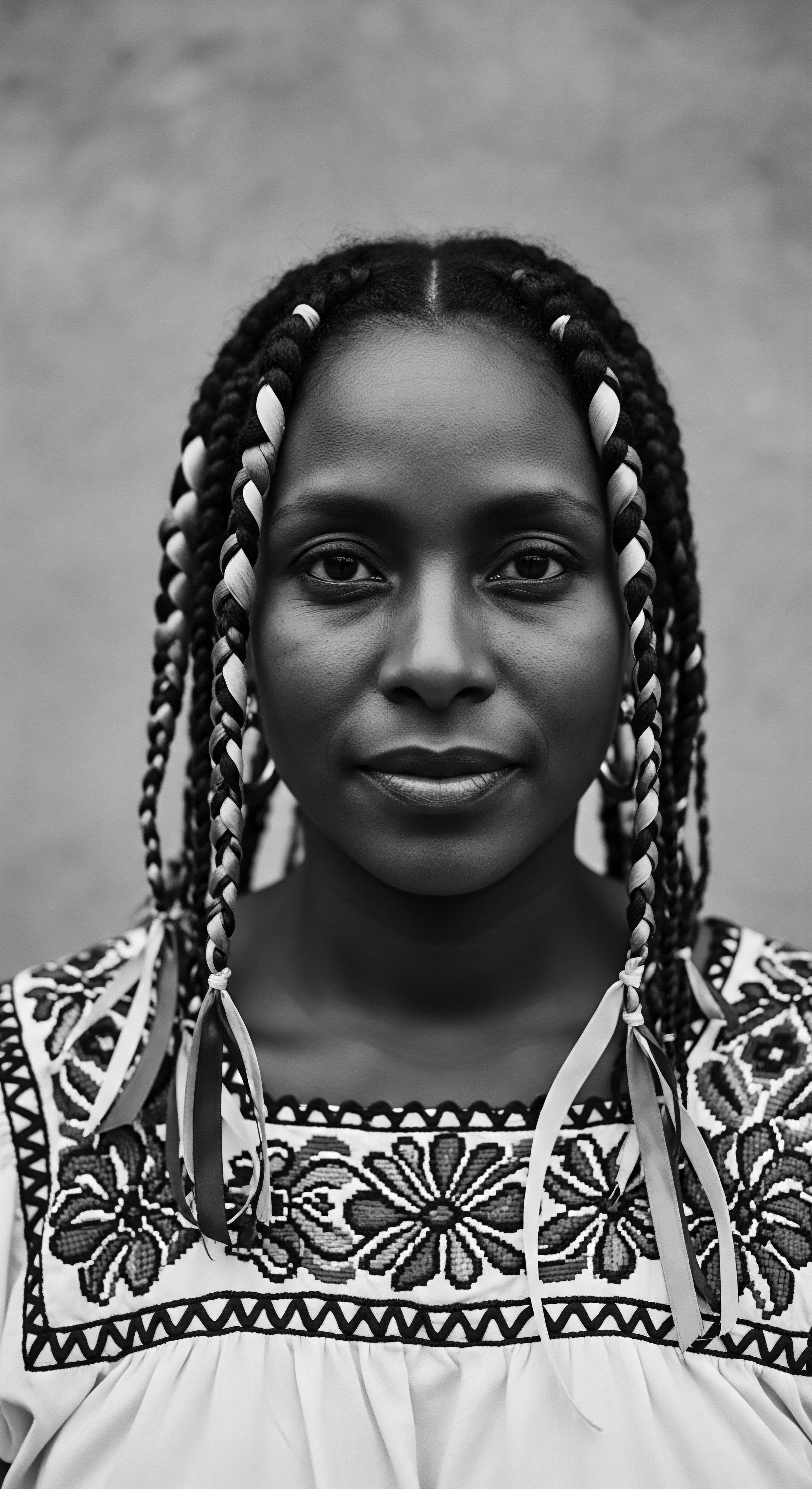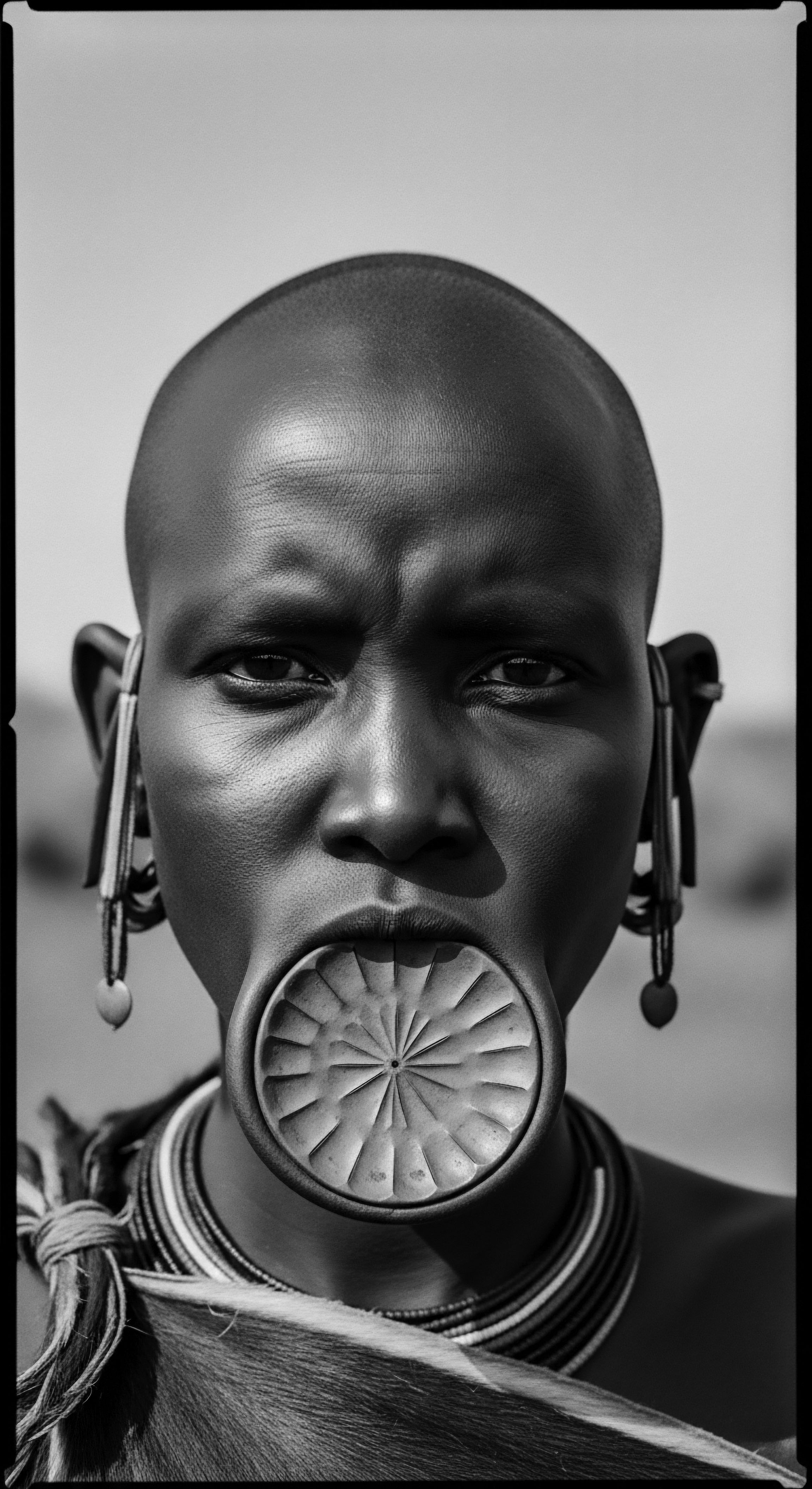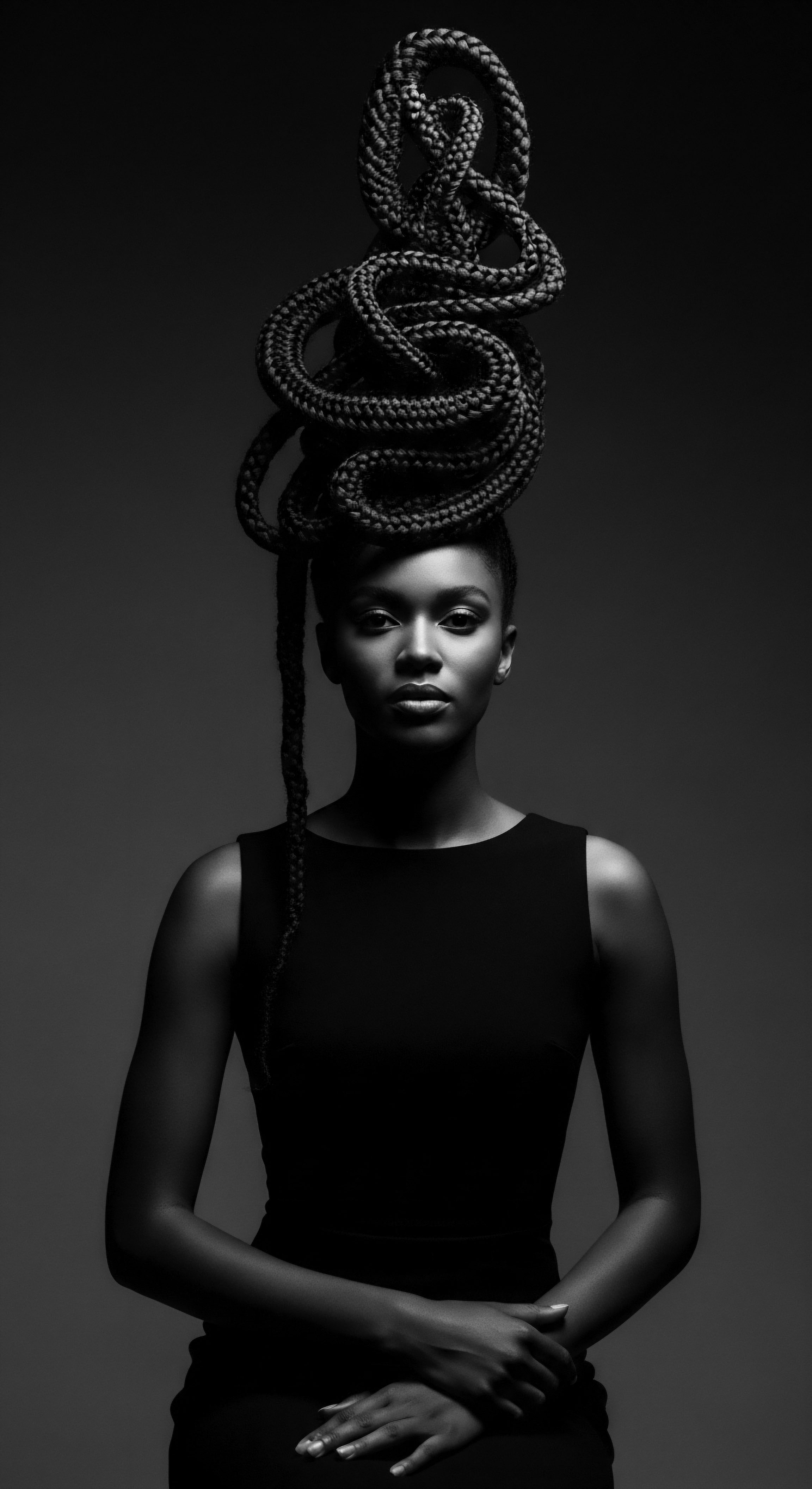
Roots
When we consider the profound relationship between our strands and the bounty of the earth, we are not merely observing a superficial act of beautification. This connection runs far deeper, echoing the very pulse of ancestral wisdom, particularly for those whose lineage carries the intricate coils and rich undulations of textured hair. Our exploration begins at the cellular bedrock, examining how the ancient knowledge of plant-based remedies, passed down through generations, finds its affirmation in the precise language of modern science. How, precisely, do the elemental constituents of the plant kingdom speak to the biological needs of textured hair, validating practices that have nourished our crowns for centuries?
The unique architecture of textured hair—its elliptical cross-section, the varied patterns of disulfide bonds, and the cuticle scales that often lift at the curves—renders it particularly prone to dryness and breakage. This structural complexity, beautiful in its diversity, necessitates a distinct approach to care, one often instinctively understood by our forebears. Long before the advent of industrial chemistry, communities across the African continent and its diaspora turned to the immediate environment for solutions, cultivating a pharmacopoeia of botanical remedies.
These practices were not random acts; they were systems of understanding, refined through observation and intergenerational transmission. The science of today, with its sophisticated microscopes and molecular analyses, often reveals the profound efficacy of these original methods, providing a robust scientific basis for their continued relevance.

Hair Anatomy and Physiological Specifics
Textured hair, from its earliest cellular formation, exhibits a unique helical symmetry within the follicle, contributing to its curl pattern. This helical growth causes a more uneven distribution of keratin and a higher likelihood of cuticle lifting at the curves, which can make the hair more vulnerable to moisture loss and external damage. The intricate twists and turns also create more points of contact between strands, increasing friction and the potential for tangles.
Ancient practitioners, through empirical observation, understood this innate tendency for dryness and breakage, formulating botanical preparations that targeted these specific needs. For instance, the traditional use of emollient plant butters and oils, like those derived from the shea tree, provided a protective coating, mimicking the natural sebum that struggles to travel down the spiraling strand.
The structural distinctiveness of textured hair often renders it more susceptible to moisture depletion and mechanical stress, a reality long addressed by ancestral plant-based remedies.
Consider the role of scalp health. A healthy scalp is the very foundation for thriving hair, especially for textured hair which can experience conditions like dry scalp or folliculitis due to tighter curl patterns and product buildup. Traditional practices frequently involved herbal rinses and scalp massages using concoctions designed to soothe, cleanse, and stimulate. Contemporary scientific inquiry frequently supports these ancient wisdoms.
Research has shown that certain plant extracts possess anti-inflammatory and antimicrobial properties, directly addressing scalp conditions that hinder optimal hair growth. For example, compounds found in various indigenous African plants have been identified as possessing properties beneficial for maintaining a balanced scalp microbiome (Adebayo, 2011).

Ancestral Understanding of Growth Cycles
The human hair growth cycle—anagen (growth), catagen (transition), and telogen (resting)—is universal, yet its duration and health can be influenced by internal and external factors, including nutrition, stress, and, significantly, consistent care practices. Ancestral communities, lacking modern dermatological tools, developed routines that, by their very nature, supported prolonged anagen phases and minimized premature shedding. Their understanding was often cyclical, aligning with the rhythms of nature, much like the plants they harvested.
Diet, deeply connected to plant life, was a cornerstone of this holistic view. The consumption of nutrient-rich plant foods, teeming with vitamins, minerals, and antioxidants, directly impacted hair health from within. This internal nourishment complemented external applications of plant-based treatments, creating a synergistic approach to hair vitality. The deep reverence for the earth and its offerings, evident in many Black and mixed-race traditions, meant that hair care was not isolated; it was part of a broader wellness philosophy, intrinsically linked to the sustenance derived from the land.
| Textured Hair Characteristic Elliptical Follicle/Coiled Strand |
| Traditional Plant-Based Remedy Shea Butter (Vitellaria paradoxa), Coconut Oil (Cocos nucifera) |
| Scientific Insight Confirmation Rich in fatty acids (stearic, oleic, lauric), these emollients effectively coat the hair shaft, reducing friction and moisture loss. Lauric acid in coconut oil can penetrate the hair shaft, reducing protein loss (Rele & Mohile, 2003). |
| Textured Hair Characteristic Cuticle Lift and Fragility |
| Traditional Plant-Based Remedy Hibiscus (Hibiscus rosa-sinensis) infusions, Aloe Vera (Aloe barbadensis miller) gels |
| Scientific Insight Confirmation Hibiscus contains mucilage, which provides conditioning and smoothing effects, potentially flattening cuticles. Aloe vera's polysaccharides and enzymes act as humectants and emollients, improving strand flexibility. |
| Textured Hair Characteristic Scalp Dryness/Inflammation |
| Traditional Plant-Based Remedy Neem (Azadirachta indica) oil, Baobab (Adansonia digitata) oil, various herbal rinses |
| Scientific Insight Confirmation Neem exhibits anti-inflammatory and antiseptic properties due to compounds like nimbin and nimbidin (Subapriya & Nagini, 2005). Baobab oil is rich in Omega-3 fatty acids, which aid in reducing scalp inflammation and dryness. |
| Textured Hair Characteristic Ancestral plant selection for hair care was deeply informed by an intuitive understanding of textured hair's specific needs, frequently validated by modern scientific analysis of botanical properties. |

Ritual
The daily rhythms of hair care, particularly within communities of textured hair, transcend simple hygiene; they are imbued with a deep cultural significance, a continuum of practices that have shaped identity and preserved heritage. What scientific insights confirm the benefits of traditional plant-based hair care in the context of these enduring rituals of styling and transformation? This question invites us to consider how centuries of ancestral wisdom in preparing and applying botanical elements have not only adorned crowns but also underpinned the health and resilience of our coils. The act of styling, often communal and deeply personal, became a conduit for knowledge transfer, each braid, twist, or press a tangible manifestation of ancestral ingenuity.
From the meticulous plaiting of protective styles, designed to shield delicate strands from environmental stressors, to the careful application of nutrient-rich salves and oils, traditional plant-based care formed the backbone of these rituals. The scientific lens now allows us to appreciate the molecular mechanisms behind what our ancestors knew instinctively ❉ that certain plant compounds could reduce friction, enhance elasticity, and fortify the hair fiber against breakage. The rhythmic motion of hands through hair, applying botanical preparations, was not just about aesthetics; it was a profound act of care, a conversation between practitioner, recipient, and the very spirit of the plant itself.

Protective Styling and Plant Synergies
Protective styling, deeply woven into the heritage of Black and mixed-race communities, serves a dual purpose ❉ aesthetic expression and structural preservation. Styles such as cornrows, braids, and twists minimize manipulation of the hair shaft, thereby reducing mechanical stress and breakage. The genius of ancestral hair care was often in the marriage of these protective styles with plant-based treatments. For instance, before braiding, hair was often saturated with specific plant oils or butters.
Consider the long-standing tradition of oiling the scalp and strands prior to braiding, a practice evident across numerous African cultures. Scientific examination of oils such as Castor Oil (Ricinus communis) reveals its unique fatty acid composition, particularly ricinoleic acid, which possesses anti-inflammatory and antimicrobial properties, benefiting scalp health. When applied to the hair shaft, these oils reduce the coefficient of friction, allowing for smoother manipulation during braiding and minimizing inter-strand friction that causes breakage (Keis, 2005). The occlusive nature of some plant butters creates a barrier, sealing in moisture and protecting the hair from external humidity fluctuations or dry air, both of which can lead to swelling and shrinking of the hair shaft, causing damage over time.

Traditional Definition and Botanical Aids
Achieving definition in textured hair often involves enhancing the natural curl pattern, a process that historically relied on specific plant extracts. Think of mucilaginous plants, those that yield a slippery, gel-like substance when soaked. For example, Flaxseed (Linum usitatissimum) has been used in various traditional contexts to create a natural styling gel.
Scientific analysis shows flaxseed mucilage is rich in polysaccharides, which form a flexible film around the hair strand, defining curls without causing stiffness. This film also provides a protective layer against environmental aggressors.
Similarly, the use of plants like Okra (Abelmoschus esculentus) for hair care in certain African traditions capitalized on its mucilaginous properties. When boiled, okra produces a slippery liquid that, when applied to hair, can provide slip for detangling and gentle hold for curl definition. These natural polymers present in plants offer a gentler, more breathable alternative to many synthetic styling agents, allowing the hair to maintain its inherent flexibility while supporting its natural form.
The intentional pairing of protective styles with plant-derived remedies exemplifies an ancient wisdom, scientifically supported, designed to fortify delicate hair fibers against daily stress.
The tools themselves, often crafted from natural materials, were part of this ritualistic application. Wooden combs, horn picks, and even dried gourds used for pouring rinses, all contributed to a holistic system of care. These natural tools, unlike some modern plastic alternatives, reduced static and snagging, working in concert with the plant-based preparations to treat the hair with reverence.
- Plant Oils ❉ Used to lubricate and seal hair strands, reducing breakage during styling and protecting against environmental elements.
- Mucilage-Rich Botanicals ❉ Applied for natural curl definition, providing hold and enhancing flexibility without harsh chemicals.
- Herbal Infusions ❉ Employed as rinses to condition, detangle, and impart shine, leveraging the botanical extracts for overall hair vitality.

Relay
The continuity of care, a relay across generations, stands as a testament to the enduring power of traditional plant-based hair practices. This passing of wisdom, often through observation and hands-on guidance from elder to youth, forms the very backbone of textured hair heritage. What scientific insights confirm the benefits of traditional plant-based hair care, translating ancient remedies into the lexicon of molecular biology and dermatology, thereby solidifying their place in contemporary holistic wellness? This calls for a deep exploration, moving past anecdotal evidence to rigorously backed studies that articulate the biochemical marvels within these botanical allies.
Our ancestors, through profound connection to their environment, discerned the specific properties of plants without the aid of laboratories. They knew the soothing touch of aloe, the moisturizing richness of shea, and the fortifying essence of specific herbs. Modern science now dissects these intuitive understandings, identifying the active compounds—polysaccharides, saponins, triterpenes, flavonoids—that confer these benefits.
This intellectual bridge between historical practice and present-day scientific validation not only elevates traditional knowledge but also offers new avenues for hair care, rooted in the genuine efficacy of natural sources. It confirms that the plant kingdom holds a sophisticated pharmacy, tailored by nature to support the health and vitality of textured hair.

Decoding Traditional Ingredients with Modern Science
The efficacy of traditional plant-based hair care is increasingly supported by phytochemical analysis and clinical studies. Consider the widespread use of Butyrospermum Parkii, commonly known as shea butter, across West African communities. Historically, it has been used as a deep conditioner and sealant. Modern scientific analysis reveals shea butter’s complex lipid profile, including high concentrations of oleic and stearic acids, which contribute to its occlusive properties.
It forms a protective barrier on the hair shaft, reducing transepidermal water loss and preventing moisture evaporation. Beyond simple lubrication, shea butter contains non-saponifiable compounds, such as cinnamic acid esters, which possess anti-inflammatory and antioxidant activities. These components not only condition hair but also soothe and protect the scalp (Tella, 2017). This provides a clear scientific rationale for its long-standing popularity in traditional hair regimens for textured hair, which benefits immensely from lipid enrichment and protection.
Another powerful example hails from Indian ancestral practices, widely adopted across the diaspora, is the use of Amla (Phyllanthus emblica), also known as Indian gooseberry. It is often lauded for its hair-strengthening and growth-promoting attributes. Scientific studies have isolated specific compounds in Amla, particularly vitamin C, gallic acid, and ellagic acid, which are potent antioxidants. These antioxidants protect hair follicles from oxidative stress, a known contributor to hair damage and loss.
Furthermore, Amla has been shown to inhibit 5-alpha reductase, an enzyme linked to androgenetic alopecia, suggesting a biochemical mechanism for its traditional use in supporting hair growth and density (Kumar et al. 2012). This deep dive into its biochemical actions explains why Amla has been a cornerstone of traditional hair care for millennia.

Nighttime Sanctuaries and Bonnet Wisdom
The ritual of preparing hair for sleep, particularly the use of silk or satin bonnets and scarves, is a cornerstone of textured hair care, deeply rooted in ancestral practices aimed at preservation. What scientific insights confirm the benefits of traditional plant-based hair care when combined with this essential protective measure? The science speaks to minimizing friction, preserving moisture, and preventing mechanical damage.
During sleep, ordinary cotton pillowcases create significant friction against hair, especially textured strands which are more prone to tangling and breakage due to their coiled structure. This friction can disrupt the cuticle layer, leading to frizz and split ends. Silk and satin, with their smooth, tightly woven fibers, drastically reduce this friction. By wrapping hair in these materials, traditional practices effectively created a micro-environment that preserved the hair’s integrity.
When plant-based emollients, applied as part of a pre-sleep regimen, are sealed in by the bonnet, their moisturizing and strengthening effects are amplified, preventing product evaporation and allowing the hair to absorb the botanical goodness over a longer period. This harmonious combination of ancient wisdom and material science provides a compelling answer to why these nighttime rituals are so enduringly effective for textured hair.
The synergy of traditional plant applications with protective nighttime coverings, like silk bonnets, scientifically reduces friction and seals in vital moisture for textured hair, validating ancestral preservation methods.

Holistic Wellness and Hair Health
Ancestral wellness philosophies frequently emphasize the interconnectedness of mind, body, and spirit. Hair health was seldom viewed in isolation but as a reflection of overall well-being. This holistic perspective, which underpins traditional plant-based care, is increasingly gaining scientific validation.
The stress response, for instance, has a direct physiological impact on hair growth cycles, potentially leading to telogen effluvium (stress-induced hair shedding). Traditional practices often included not only topical plant applications but also dietary modifications, stress-reducing rituals, and community support—all contributing to a state of balance.
For example, the incorporation of adaptogenic plants in diet or topical applications, though not always consciously labeled as such in historical contexts, provided systemic benefits. While specific studies on traditional African adaptogens for hair are emerging, the general science on stress reduction and its impact on the body, including hair, is robust (Arora et al. 2021). The gentle, intentional application of plant-based products, often accompanied by massage, can also induce a parasympathetic response, reducing stress and promoting relaxation.
This confirms that the benefits of traditional plant-based hair care extend beyond localized effects on the hair shaft, reaching into the broader realm of systemic health and the well-being of the individual within their community. This deeply rooted heritage connects personal care to collective vitality, a relay of wisdom that continues to inform our present.
- Shea Butter (Butyrospermum Parkii) ❉ A cornerstone of West African hair care, its high concentration of oleic and stearic acids provides occlusive properties that seal moisture, while its non-saponifiable components offer anti-inflammatory benefits to the scalp.
- Amla (Phyllanthus Emblica) ❉ Used in South Asian traditions, this potent antioxidant protects hair follicles from oxidative stress and may inhibit enzymes linked to hair loss, promoting density and growth.
- Castor Oil (Ricinus Communis) ❉ Valued for its unique ricinoleic acid content, it offers antimicrobial benefits to the scalp and reduces friction on hair strands, aiding in detangling and protecting against breakage during manipulation.

Reflection
As we step back, taking in the grand sweep of knowledge shared, a luminous truth comes into focus ❉ the benefits of traditional plant-based hair care, whispered through generations and validated by the discerning eye of science, are not merely facts. They are echoes from the source, vibrant stories etched into the very helix of textured hair. This journey, from elemental biology to the nuanced artistry of ancestral rituals, reveals a profound continuity, a tender thread connecting us to those who came before. It is a testament to ingenuity, resilience, and an unwavering spirit of beauty, deeply ingrained within Black and mixed-race heritage.
Our exploration has sought to demonstrate how the scientific insights of today affirm the intuitive wisdom of yesterday, grounding our understanding in a shared legacy. The very act of caring for textured hair, armed with this knowledge, becomes a mindful engagement with history, a celebration of identity, and a quiet declaration of self-possession. Each strand, imbued with the light of this understanding, ceases to be just hair; it becomes a living archive, a narrative of survival, flourishing, and the enduring power of roots. This is the Soul of a Strand ❉ a perpetual return to the wellspring of ancestral knowledge, ever-evolving, yet eternally true.

References
- Adebayo, E. A. (2011). Herbal remedies for hair loss and dandruff. In A. Adebayo & P. Olufunmilola (Eds.), African Medicinal Plants (pp. 145-167). CRC Press.
- Arora, R. Sharma, H. & Saxena, P. S. (2021). A comprehensive review on adaptogenic plants for hair health. Journal of Pharmacy & Bioallied Sciences, 13(Suppl 1), S34-S40.
- Keis, K. (2005). The effect of various cosmetic oils on the hair shaft (Master’s thesis). University of Cincinnati.
- Kumar, N. Rungta, A. Chauhan, N. S. & Dixit, V. K. (2012). Amla (Emblica officinalis Gaertn.) for hair ❉ A review. Journal of Cosmetic Dermatology, 11(3), 209-216.
- Rele, J. S. & Mohile, R. B. (2003). Effect of mineral oil, sunflower oil, and coconut oil on prevention of hair damage. Journal of Cosmetic Science, 54(2), 175-192.
- Tella, A. (2017). Shea butter ❉ Properties and traditional uses in African medicine and cosmetology. Academic Press.
